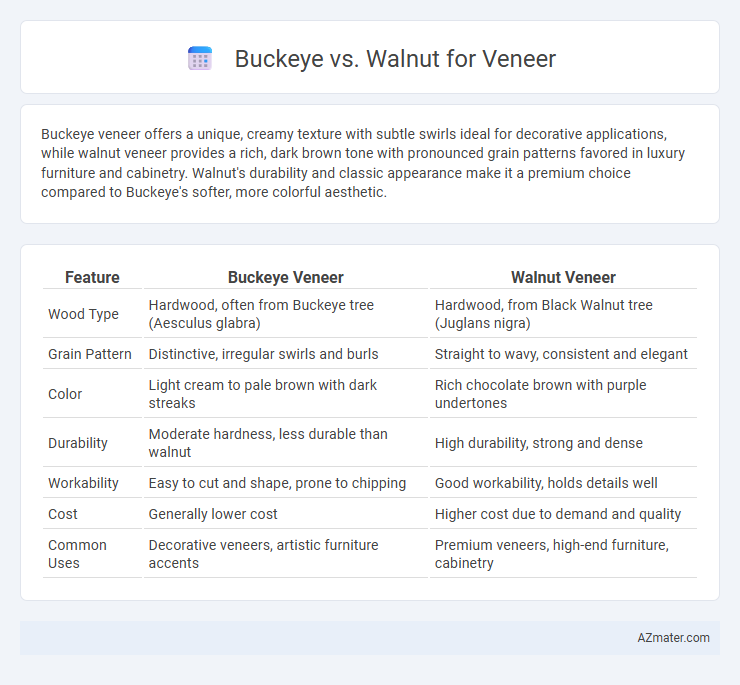Buckeye veneer offers a unique, creamy texture with subtle swirls ideal for decorative applications, while walnut veneer provides a rich, dark brown tone with pronounced grain patterns favored in luxury furniture and cabinetry. Walnut's durability and classic appearance make it a premium choice compared to Buckeye's softer, more colorful aesthetic.
Table of Comparison
| Feature | Buckeye Veneer | Walnut Veneer |
|---|---|---|
| Wood Type | Hardwood, often from Buckeye tree (Aesculus glabra) | Hardwood, from Black Walnut tree (Juglans nigra) |
| Grain Pattern | Distinctive, irregular swirls and burls | Straight to wavy, consistent and elegant |
| Color | Light cream to pale brown with dark streaks | Rich chocolate brown with purple undertones |
| Durability | Moderate hardness, less durable than walnut | High durability, strong and dense |
| Workability | Easy to cut and shape, prone to chipping | Good workability, holds details well |
| Cost | Generally lower cost | Higher cost due to demand and quality |
| Common Uses | Decorative veneers, artistic furniture accents | Premium veneers, high-end furniture, cabinetry |
Introduction to Buckeye and Walnut Veneer
Buckeye veneer is prized for its distinctive, swirling grain patterns and light brown to creamy white color, offering a unique, eye-catching appearance in woodworking projects. Walnut veneer, known for its rich, dark chocolate brown hues with subtle purples and straight grain, provides a classic, elegant finish favored in high-end furniture and cabinetry. Both veneers are valued for their durability and workability, but Buckeye's bold patterns contrast with Walnut's smooth, consistent texture, catering to different aesthetic preferences.
Origins and Species Overview
Buckeye veneer originates from the Aesculus genus, primarily found in Eastern North America, known for its soft texture and unique, swirling grain patterns. Walnut veneer comes mainly from the Juglans genus, particularly the Black Walnut species native to the central and eastern United States, prized for its rich, dark color and straight grain. Both species offer distinct aesthetic qualities, with Buckeye providing lighter hues and intricate figuring, while Walnut delivers deeper tones and a straighter grain ideal for fine furniture.
Visual Characteristics and Grain Patterns
Buckeye veneer features striking, irregular patterns with swirling grain and distinct light and dark zones creating a dramatic visual impact. Walnut veneer is characterized by a rich, uniform chocolate-brown color with straight grain patterns that enhance its smooth and elegant appearance. The combination of Buckeye's bold, contrasting textures and Walnut's consistent grain makes them distinct choices for decorative surfaces.
Color Variations and Aesthetic Appeal
Buckeye veneer offers distinct creamy white to light tan hues with striking deep brown or reddish streaks, creating a dramatic and unique visual appeal ideal for artistic woodworking projects. Walnut veneer displays rich, warm chocolate browns with occasional purplish tones and fine, straight grain that lends a classic and elegant sophistication to furniture and cabinetry. The contrasting color variations in Buckeye produce bold, eye-catching patterns, while Walnut's consistent and smooth palette enhances timeless refinement and subtle luxury.
Durability and Hardness Comparison
Buckeye veneer is softer with a Janka hardness rating around 540, making it less durable and more prone to dents compared to Walnut, which boasts a Janka hardness of approximately 1010. Walnut veneer offers superior resistance to wear and impact, making it more suitable for high-traffic areas and long-lasting applications. The significant difference in hardness values highlights Walnut as the preferred choice for durability in furniture and cabinetry projects.
Workability and Machining Properties
Buckeye veneer exhibits excellent workability due to its fine, consistent grain and moderate density, allowing for smooth cutting and shaping. Walnut veneer, known for its natural oils and tighter grain, offers good machining properties but requires sharper tools to avoid chipping and tear-out. Both veneers respond well to sanding and finishing, with Buckeye providing more forgiveness during machining and Walnut delivering a richer texture and durability.
Common Applications in Woodworking
Buckeye veneer is prized for its intricate burl patterns and is commonly used in high-end furniture, musical instruments, and decorative paneling to create visually striking accents. Walnut veneer offers a rich, warm tone with straight grain, making it ideal for cabinetry, luxury furniture, and architectural millwork where durability and classic elegance are essential. Both veneers are favored in woodworking projects that demand a balance of aesthetic appeal and functional strength.
Cost and Availability Factors
Buckeye veneer is generally more affordable than walnut due to its faster growth rate and wider availability, making it a cost-effective choice for large projects. Walnut veneer, prized for its rich color and fine grain, commands a higher price and may be harder to source consistently because of limited supply and slower growth. Both veneers are sought after in cabinetry and furniture, but budget constraints and project scale often influence the selection between cost-effective buckeye and premium walnut options.
Environmental Impact and Sustainability
Buckeye veneer is generally considered more sustainable due to its faster growth rate and abundance, resulting in less environmental strain compared to walnut. Walnut trees take decades to mature, making walnut veneer a less renewable resource with a larger ecological footprint. Choosing buckeye reduces deforestation risks and promotes responsible forestry management through quicker replenishment cycles.
Choosing the Right Veneer for Your Project
Buckeye veneer offers a unique blend of creamy tones and contrasting dark streaks, ideal for adding visual interest to custom furniture and decorative panels. Walnut veneer provides rich, deep brown hues with fine, straight grain patterns, perfect for classic, elegant interiors requiring durability and timeless appeal. Selecting between Buckeye and Walnut veneer depends on your project's aesthetic goals and environmental conditions, ensuring the material complements design intent and functional needs.

Infographic: Buckeye vs Walnut for Veneer
 azmater.com
azmater.com